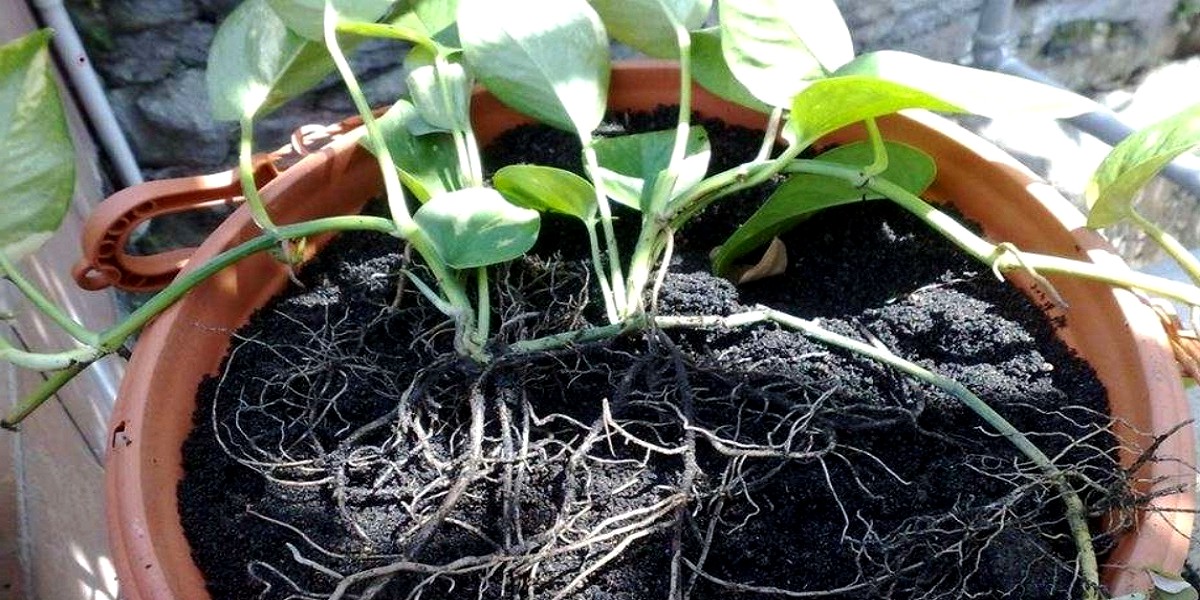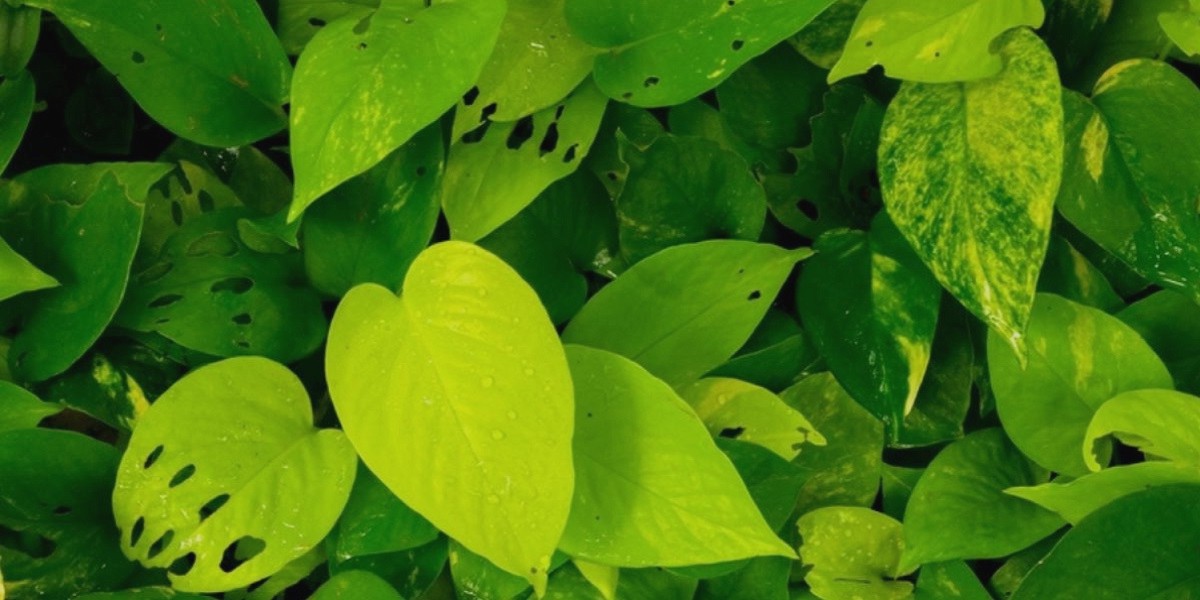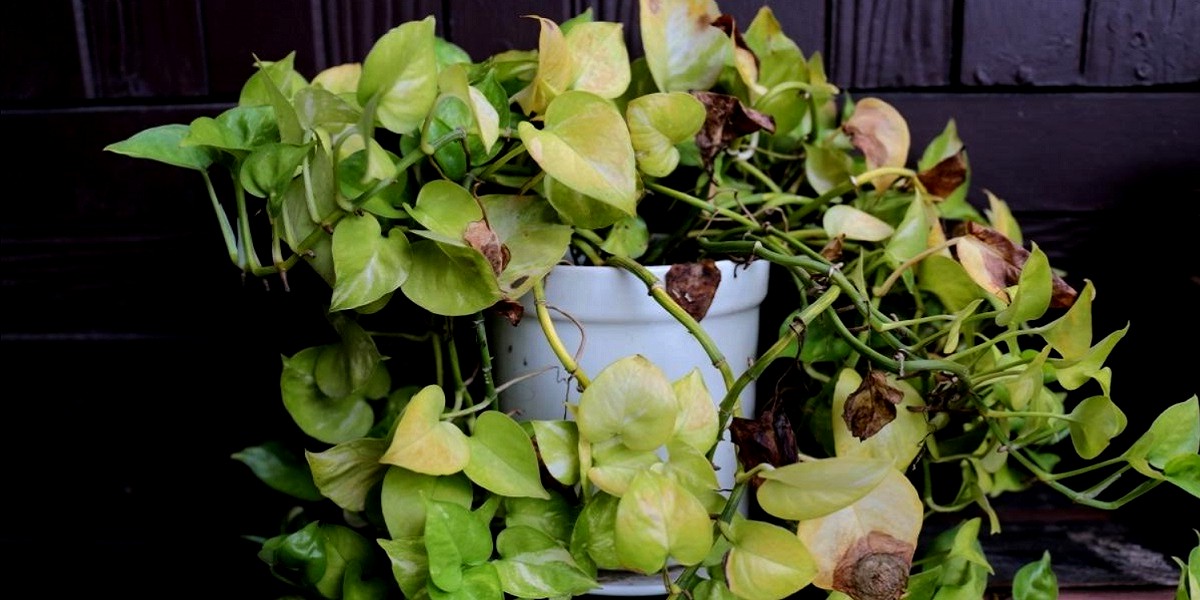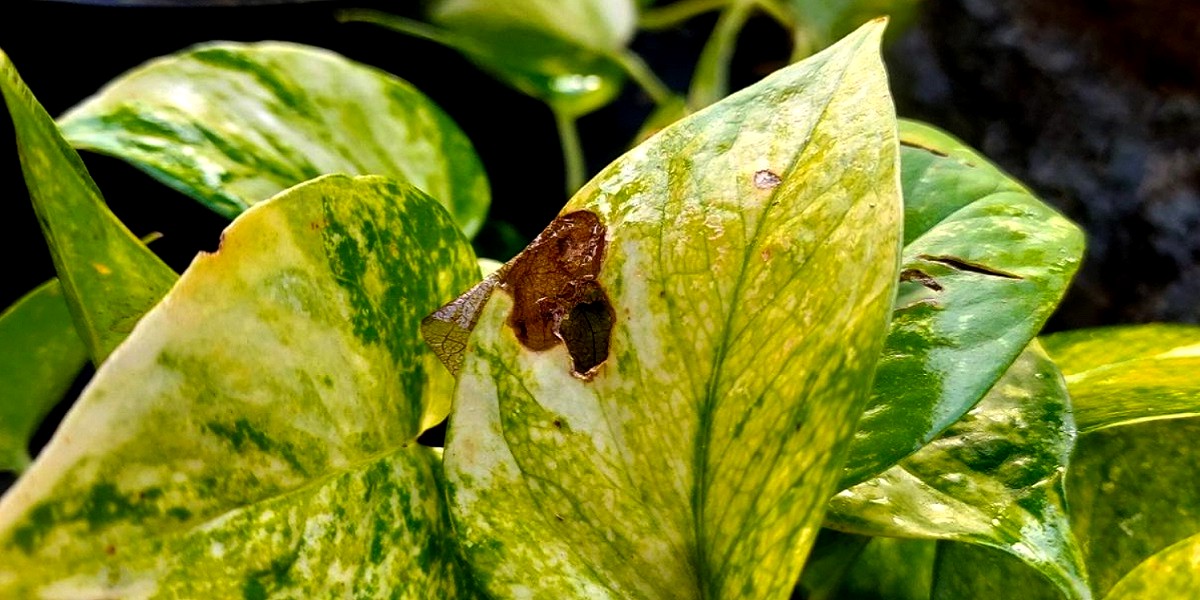Sometimes referred to lovingly as devil’s ivy or money plant, pothos is an indoor arum plant that originated in the southeast of Asia but is now popular pretty much across the globe. Its evergreen waxy-looking heart-shaped leaves can be seen outdoors, too, but these varieties are generally larger. It’s arguably one of the best houseplants to grow in a hanging pot, and the way it can climb walls and other vertical supports cannot but astonish those who observe it.
While also much appreciated by experienced gardeners, pothos is one the most popular choices with beginners and those who have long lost faith in their green thumbs because it doesn’t require much special care and is believed to be resistant to most afflictions that not-so-sturdy plants tend to fall victim to. Unfortunately, the latter is not exactly the truth. There are pathogens that can affect pothos plants, causing nasty-looking brown spots to appear on the leaves. It turns out that attributing the problem to a specific disease can de difficult because it can also be caused by factors in the environment.
The purpose of this article is to make it easier for you to identify the nature of golden pothos brown spots or neon pothos brown spots, or other suspicious-looking marks on the leaves that look like a sign of one or more pothos diseases. It also explains how to find the best cure based on your knowledge of the problem and to prevent it from ever returning.
What Is Behind Pothos Brown Spots?
Brown spots are not specific to a particular disease or problem. Rather, it’s a sign that your pothos might be abused in terms of growth condition or affected by one of pothos diseases. You can spare yourself a lot of time trying to identify the problem with the help of our specialized application, which can help you determine the diagnosis based on a photo you take. We still advise you to be familiar with the most common causes of brown-colored spots and blotches in pothos plants so that you can combine your knowledge with artificial intelligence for maximum efficiency.
Phytophthora root rot
This is not exactly what you might refer to as a brown spots disease because its manifestations are not limited to a spotty appearance. However, dark blotches on leaves are among its signs. The problem usually develops in a cutting shortly after you start a new plant. This is not to say that it won’t affect a mature pothos later, though.

Roots are the primary target of phytophthora, and it’s around them that it usually begins. As it spreads, however, the leaves can also acquire brown spots. Stems are often affected as well, and discoloration is not the only sign; you might notice that the leaves are drooping and look wilted.
Phytophthora transmission mechanism is based on spores, which can survive in the soil for years. The only thing they need to become active is moisture. That is, stagnant water due to overwatering is the primary cause of root rot in pothos, although technically, it’s caused by a living organism.
Bacterial/Fungal Leaf Spot
Generally, it’s not common for pothos plants to contract leaf spot plant diseases. This is not to say that you can rule it out as a possibility without giving it further consideration if you see brown spots on its leaves, though. Fungal infections can manifest in small elevated spots or larger flat patches that are brown in color, a sign that a pathogenic fungus is using the plant to its own advantage.
It’s important not to treat a leaf spot disease in pothos as a mere eyesore. If left unattended, the plant can quickly succumb to it, and the infection is almost bound to spread to other plants nearby. Adequate treatment should include topical fungicide as well as environmental measures such as ensuring good airflow and making sure that no water accumulates on the leaves. For more details on this, read the What to Do section.
Pests
Pothos plants are generally sturdy but can become prone to various types of pests when under stress, in particular spider mites. This kind of pest attaches itself to the leaves and feeds on cell tissue, damaging the foliage and leaving characteristic webbing and curled leaves. Their infestation can cause the plant to become discolored and start losing its leaves.

Other common pothos pests include mealybugs, thrips, and scale. The problem with these insects is that they all damage pothos tissues, which is an aesthetic problem and also a blow that affects the plant’s overall scale. Each pest has its own signs by which you can spot it even if you don’t see a live culprit. It’s always best to use specialized software to identify the problem so that you don’t make a mistake that costs you too much. Just like with leaf spot diseases, you’ll need to combine treatment and prevention. Read the What to Do part of this article for more details on available natural remedies and commercial solutions.
Too much fertilizer
Fertilizer can be good for your pothos and boost its growth considerably, provided that you apply it at the right time and in the right amount. However, choosing one that’s safe for your case can be a challenge. Some fertilizers can leave burn-like scorches that can be white or brown.
Certain fungicides can have the same effect, which is another reason why you should not skip the disease identification part when deciding which product to use. If you can avoid potentially damaging substances, it’s best not to use them.
Scorches like this do not require any special care except that you need to cut off the damaged leaves and reconsider your gardening routine.
Exposure to direct sunlight
Plants are pretty much like us humans in that they can get sunburnt when exposed to a lot of sunlight. In this case, you’ll notice yellow and brown patches on the leaves, especially close to the edges. It is not a common situation because pothos can thrive in a variety of light conditions, from relatively dim to reasonably bright, but it is possible if you place it too close to the window.
Burns
Heat burns are similar to those caused by sunlight but occur in different circumstances, namely near heat-emanating objects and devices such as radiators. It is generally considered bad practice to place plants near such sources of heat. If this happens occasionally, you might need to remove the damaged leaves and move the plant.

Watering Issues
A balanced watering approach that’s responsive to the need of each individual plant is preferable to simply adhering to a schedule because it helps you avoid over- as well as underwatering. Either problem will cause aesthetic problems in the leaves, including drooping and dark spots.
If the soil is too wet, it can cause root rot (see above to learn why it is dangerous) and ultimately death. It is essential to always ensure appropriate drainage while also avoiding letting your pothos dry out. Alternating between the extremes won’t solve the problem; you need to learn to keep the soil reasonably moisturized.
Low Humidity
Dry and hot air is a problem for many plant species and not just the pothos family. It often causes brown spots to appear on the leaves, which are usually located close to the edges. When the situation gets critical, foliage may even start to fall, so it’s essential that you maintain an appropriate level of humidity in the air.
Misting your pothos can be a viable solution as long as it doesn’t leave the leaves wet. As you might know from the above sections, excess moisture on foliage can cause fungal infections.
Spotting the Problem
The earlier to detect and identify the problem that’s causing brown spots on pothos leaves, the higher chance you have of finding a natural remedy that will actually work without damaging the plant, and the aesthetic cost you have to pay will be lower.
To make sure you don’t miss brown spots on your pothos, it’s always a wise decision to inspect the plants regularly, paying special attention to the bottom tiers of its foliage that may be hidden in the shade and not immediately visible. Remember to also look at the stems and around the roots to spot any signs of nascent root rot.
If you see something suspicious, the first and most important step to take is to identify it. We offer an application that can diagnose a pothos problem based on a photo you have taken. This makes the choice of control strategies much easier for you. It also reduces the risk of causing damage with unfitting treatment or leaving a problem that requires urgent intervention untreated.
What to Do If You See Pothos Leaves Turning Brown
As has been stated above, the most important part is to find out what you are dealing with. You can rely on our application to diagnose a pothos disease by the picture. The next steps will depend entirely on your findings.

Fix the environment
A large number of pothos problems that have brown spots on their leaves among their signs are attributable to poor growing conditions. Common problems include inadequate watering as well as excess moisture, exposure to harsh influences such as direct sunlight, heat, or cold draughts, and more. The most natural treatment based on the classification is to adjust whatever aspect of the environment has proven unfavorable.
With pothos, you want to avoid direct sunlight and extreme temperatures. As a rule of thumb for checking the level of soil moisture, if you stick two fingers in it and one comes out half dry, it’s likely a sign that you should give the plant a good drink. Be careful not to let it become too moist, though. This applies to both the leaves and the roots. Depending on which part is affected, unhealthy humidity might lead to the development of root rot or start a fungal disease cycle.
Apply pathogen-specific treatment
Environmental measures can be sufficient if the problem was initially caused by a problem in the environment. However, bacterial and/or fungal diseases, as well as pest infestations, are likely to require extra steps.
The market is currently full of pothos-friendly products designed to combat fungi, bacteria, and a variety of insects. Organic treatment options that are compatible with integrated pest management practices are becoming increasingly important, too, and can be used to cure an existing problem as well as for prevention afterward. One example is neem oil, made from an Asian ornamental tree, which has been proven to have insecticidal as well as fungicidal properties and is safe for your plants as long as you follow the instructions.
If you try and research this topic, you’ll see a variety of combinations that target several pathogen groups at the same time. Fungicide plus insecticide is probably the most common approach that fits into this category. Why the opportunity to treat pests and fungal diseases at the same time is extremely valuable, it also bears the risk of causing more damage than you absolutely have to (see the above section to find out how fungicides can scorch the leaves of a pothos). One common way of combining the two is mixing soap with one of the properties with its liquid counterpart for greater adhesion.
With fungi, it’s essential that you prevent spores from being spread and, figuratively, taking root. Moisture control becomes vital at this stage. Whenever there’s enough water around a spore, it will grasp the opportunity to evolve into a fully functioning, parasitic fungal organism. For this reason, we recommend avoiding overhead watering unless you can be absolutely sure the leaves will have enough time to dry.
Pothos Leaves Brown Spots: Each Case Is Unique
As you can see from the rather long section that deals with the causes of brown spots on pothos leaves, putting your finger on the culprit can be difficult. A wide variety of environmental factors can cause discoloration in pothos foliage, including the poor watering regime, exposure to heat, too much direct light, and more. However, fungal and bacterial diseases, as well as pest infestations, are also responsible for part of the cases. Fortunately, you can use our plant disease diagnosing app to identify the real cause and treat your pothos appropriately.
What experience with brown spots in pothos plants do you have? You are welcome to share it along with your advice and observations.
Leave a Reply
You must be logged in to post a comment.